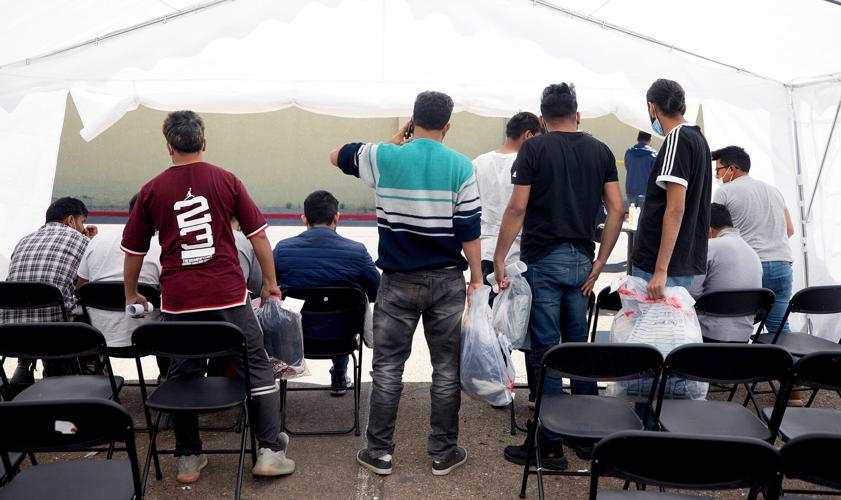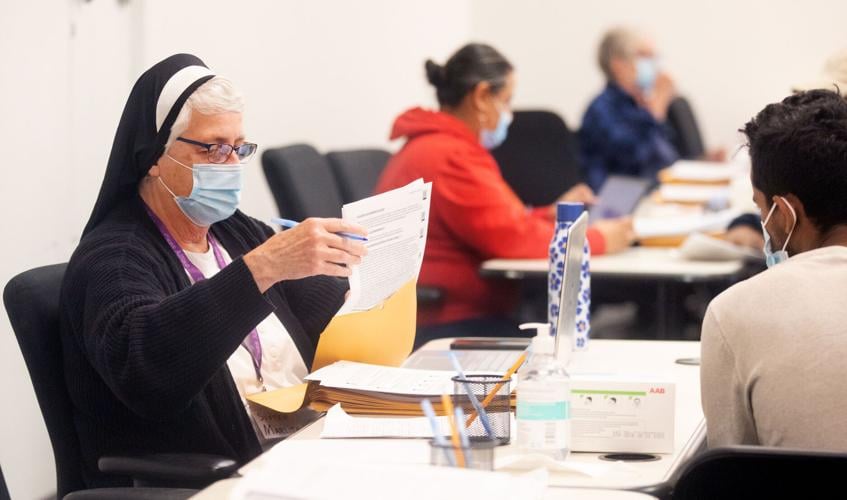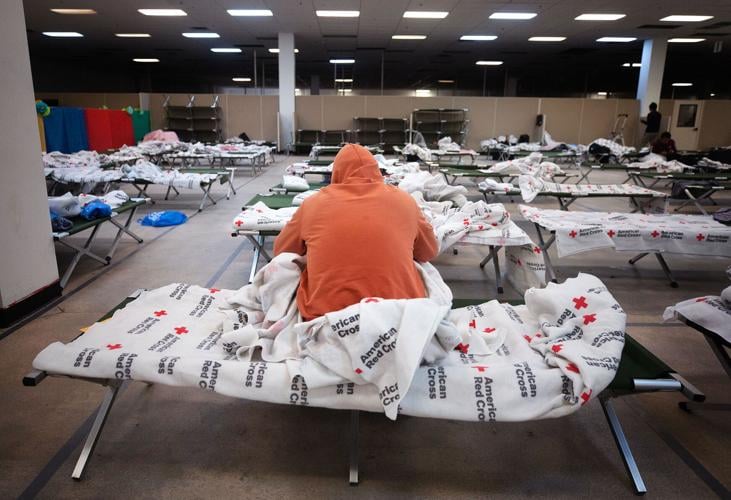Pima County’s new migrant services site is receiving a larger proportion of people from non-Spanish-speaking countries, following the Biden administration’s policy changes. And it could be in for a huge influx of people as policy changes will likely continue next month.
The new location on Tucson’s south side on West Drexel Road near Interstate 19 is part of the migrant services run by Pima County and Catholic Community Services. It has a current capacity of 170 people, as about half the site is being used. Officials are working on opening the rest, which will raise capacity to about 400 people.
The Pima County operation is currently receiving about 400 to 500 migrants a day. Women and children usually go to Casa Alitas or one of the county’s other locations, and single men stay at the new location.

A group of migrants wait to enter the new Casa Alitas Drexel Center in southwest Tucson. The center is only open to single men.
Up to 85% of single men receiving services, most recently, are from India, says Teresa Cavendish, director of operations for Catholic Community Services. It also is receiving a significant number of migrants from African countries.
Now instead of interacting in one or two different languages a day, people are now most comfortable in one of five to seven different languages. Finding people who can communicate with the variety of languages spoken at the centers is an additional challenge, and sometimes they’re left to communicate with Google translate, Cavendish says.
“Language justice is important to us,” she said. “So as we work to offer and honor language justice, they’re patient with us while we do everything we can. This is some of the most important information that they will ever receive in their lives. We know that, and so we work very hard to make sure it is being delivered to them in the language of their choice.”
Staff help the migrants with a number of important services, including assessing that they have the proper paperwork from border officials, whether they have a sponsor, and how they plan to arrive at their final destination.
The shift in countries of origin is connected to the recent policy changes, Cavendish says.
“There’s a vacuum, so when there’s kind of an opening in the vacuum, it fills with the next groups who are trying to come in, who don’t have a specific path that will allow them entry and are experiencing things in their home countries that are unsustainable for them,” Cavendish says.
President Joe Biden began a policy in October to immediately expel more migrants from Venezuela, under public health policy Title 42, while simultaneously creating more legal pathways for them to enter the country.
He announced an expansion to this policy on Jan. 5, to include migrants from Nicaragua, Cuba and Haiti. These migrants and others can apply for an exemption to Title 42 and a chance to enter the country and apply for asylum by applying on the CBP One app.

Sister Marlita Henseler, left, helps a migrant with paperwork during the intake process at the new Casa Alitas Drexel Center in southwest Tucson. The migrants are tested for COVID-19 during the intake process.
Since then the number of migrants from those countries has dropped drastically.
The number of times Border Patrol apprehended migrants from the four countries in the program has decreased from a high of nearly 99,000 in December, nationwide, to almost 36,000 and 38,000 in January and February, respectively, the last months with data available.
Besides more languages to navigate, the change in demographics at Casa Alitas and the Drexel Center means there are also added cultural accommodations to account for, especially in the different religious and spiritual practices.
“That’s something that we’re integrating into the culture of Alitas, is a shift in religious practices and cultural norms,” Cavendish says.
That includes having prayer rugs, stations where people can wash their feet before prayer, supporting people to observe Ramadan, fulfilling various food requirements, including the types of meats served, adding more vegetarian meals and accommodating fasting schedules.
“We’re altering our food requests and our food service to make sure that they know that we respect their beliefs and respect their practices and are doing our best to accommodate,” Cavendish says.
Another consideration is changing medical needs based on what people experienced in their home country.
“Our tenet, of course, is that each person matters,” Cavendish says. “So even though we make plans that impact large groups, when there are exceptions, it’s important that we work with those exceptions because these folks matter.”
On May 11, two federal policies that affect immigration are anticipated to change, which could lead to an unmanageable increase in migrants. Title 42, the public health policy that allows the government to immediately expel some migrants from the country, is set to end and new asylum rules are proposed that could limit the number of people who enter the country.
Throughout 2022, the average number of migrants coming through Pima County daily and using services ranged from 224 to 770. The record was 850, and all the county’s migrant resources were maxed out.

A migrant looks at his phone inside the new Casa Alitas Drexel Center in southwest Tucson on Thursday. The center is only allowing single men to stay there. Current capacity is 170 people.
Border Patrol estimates when Title 42 ends, the county could receive up to 1,200 to 1,500 people per day, which would overwhelm existing local capacity without significant federal support, according to a Pima County Board of Supervisors memo issued Tuesday.
The estimates are possible, Cavendish said. However, she’s not sure what the community response would be at that point, even with partner resources at the International Rescue Committee in Phoenix.
“I think it’s really hard to think of any community along the border that is fully equipped to respond to the type of numbers that are being projected,” she said.
Casa Alitas has been offering migrant services since 2014, and the various policy changes have had temporary effects on numbers, but migrants continue to come. Agreeing with many who are experts on border policy and immigration, Cavendish says that comprehensive immigration reform is the only thing that will have a lasting impact.
“History has shown that there’s not a permanent impact,” she says about short-term policy changes. “Desperation of suffering people makes its own rules.”
Joe Biden says new rules allowing asylum seekers to be returned to Mexico aim to reduce arrivals at US southern border.






